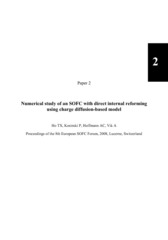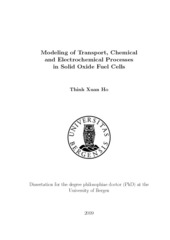| dc.contributor.author | Ho, Thinh Xuan | eng |
| dc.date.accessioned | 2009-11-26T13:48:25Z | |
| dc.date.available | 2009-11-26T13:48:25Z | |
| dc.date.issued | 2009-09-11 | eng |
| dc.identifier.isbn | 978-82-308-0869-6 (print version) | en_US |
| dc.identifier.uri | https://hdl.handle.net/1956/3609 | |
| dc.description.abstract | The working of solid oxide fuel cells (SOFCs) involve fluid dynamics, chemical reactions and electrochemical processes. These phenomena happen simultaneously in complex and sophisticated structures of the SOFC main components consisting of gas channels, porous electrodes, dense electrolyte and interconnects. Therefore, modeling of SOFCs with consideration of the detailed processes, which is indispensably important in the development of the fuel cells, is not always an easy task. The chemical reactions include the steam reforming of methane and the water– gas shift reaction. The former occurs heterogeneously on the anode surface and homogeneously in the fuel channel while the later occurs homogeneously everywhere in the anode compartment. The electrochemical reactions are oxidation of hydrogen and/or carbon monoxide and reduction of oxygen, which take place at the so-called ”three-phase boundaries” (TPBs) formed by the presence of all three of the electrode, the electrolyte and the gas phase. When ionic–electronic conducting composite electrodes are used, the TPBs extends from electrode–electrolyte interfaces into the electrodes forming an electrochemically active layer with finite thickness. A numerical model for the detailed processes happening in SOFCs is always needed. Advantage of a model is that it can provide detailed insights into the cells that can not be gained by experiments. Additionally, it helps investigating impacts of each process parameter and their interaction, giving information for cell optimization. Modeling of SOFCs has been increasing rapidly during the last two decades, especially the last few years. However, models considering detailed processes taking place at TPBs or considering effects of the composite electrodes are still relatively rare. This thesis develops a detailed numerical model for planar solid oxide fuel cells. In this model, the electrochemical reactions are assumed to take place in the electrochemically active (functional) layers of finite thickness. The thickness of these functional layers is up to 50μm, and depends among other things on the size of the particles from which the electrodes are made. The heat of the electrochemical reactions is assumed to be released on the anode side. Moreover, steady-state electrical field-driven transport of electrons and oxygen-ions in the composite electrodes– electrolyte assembly are modeled using an algorithm for Fickian diffusion built into the commercial CFD package Star-CD. Moreover, in the developed model, one single computational domain includes the air and fuel channels, the electrodes–electrolyte assembly and/or the interconnects, and thus constitutes a single and continuous domain in which balances of mass, momentum, chemical species and energy associated with chemical and electrochemical processes are solved simultaneously. The model is firstly applied to an anode-supported cell with co- and counter-flow configurations. The oxidation of carbon monoxide is included in this application, however, results show insignificant impact of it on performance of the cell. It is then applied to a cathode-supported cell, which showed a better performance in terms of temperature and current density distributions compared to the anodesupported design. In these applications, the computational domain does not include the interconnects and only variation along two directions (along the cell length and direction normal to the electrolyte surface) are captured. The model is then applied to fully three-dimensional modeling of an anode-supported cell. In this investigation, the interconnects are included, therefore, their effects on the cell performance are observed. In addition to the studies mentioned above, a discussion on transport of oxygen ions in the electrolyte is carried out. Some scenarios relating to ion fluxes are proposed, in which the Nernst–Planck and Poisson equations are solved for concentration of ions and potential distribution in the electrolyte. | en_US |
| dc.language.iso | eng | eng |
| dc.publisher | The University of Bergen | en_US |
| dc.relation.haspart | Paper 1: Chemical Engineering Science 63(21), Ho, T. X.; Kosinski, P.; Hoffmann, A. C.; Vik, A., Numerical modeling of solid oxide fuel cells, pp. 5356–5365. Copyright 2008 Elsevier Ltd. Full text not available in BORA due to publisher restrictions. The published version is available at: <a href="http://dx.doi.org/10.1016/j.ces.2008.07.021" target="blank">http://dx.doi.org/10.1016/j.ces.2008.07.021</a> | en_US |
| dc.relation.haspart | Paper 2: Ho, T. X.; Kosinski, P.; Hoffmann, A. C.; Vik, A., Numerical study of an SOFC with direct internal reforming using charge diffusion-based model, A0205. In: Proceedings of The 8th European SOFC Forum, 30th June–4th July, Lucerne, Switzerland. Reproduced with permission. Published version. | en_US |
| dc.relation.haspart | Paper 3: International Journal of Hydrogen Energy 34(8), Ho, T. X.; Kosinski, P.; Hoffmann, A. C.; Vik, A., Numerical analysis of a planar anode-supported SOFC with composite electrodes, pp. 3488–3499. Copyright 2009 International Association for Hydrogen Energy. Published by Elsevier Ltd. Full text not available in BORA due to publisher restrictions. The published version is available at: <a href="http://dx.doi.org/10.1016/j.ijhydene.2009.02.016" target="blank"> http://dx.doi.org/10.1016/j.ijhydene.2009.02.016</a> | en_US |
| dc.relation.haspart | Paper 4: Chemical Engineering Science 64(12), Ho, T. X.; Kosinski, P.; Hoffmann, A. C.; Vik, A., Modeling of transport, chemical and electrochemical phenomena in a cathode-supported SOFC, pp. 3000-3009. Copyright 2009 Elsevier Ltd. Full text not available in BORA due to publisher restrictions. The published version is available at: <a href="http://dx.doi.org/10.1016/j.ces.2009.03.043" target="blank"> http://dx.doi.org/10.1016/j.ces.2009.03.043</a> | en_US |
| dc.relation.haspart | Paper 5: Ho, T. X.; Kosinski, P.; Hoffmann, A. C.; Vik, A., 2009, Numerical modeling of SOFCs using a fully three-dimensional approach. Full text not available in BORA. | en_US |
| dc.relation.haspart | Paper 6: Ho, T. X.; Kosinski, P.; Hoffmann, A. C., 2009, Discussion on the transport of oxygen-ions in an SOFC electrolyte. Full text not available in BORA. | en_US |
| dc.title | Modeling of Transport, Chemical and Electrochemical Processes in Solid Oxide Fuel Cells | en_US |
| dc.type | Doctoral thesis | |
| dc.rights.holder | Thinh Xuan Ho | en_US |
| dc.subject.nsi | VDP::Matematikk og Naturvitenskap: 400::Fysikk: 430 | nob |

